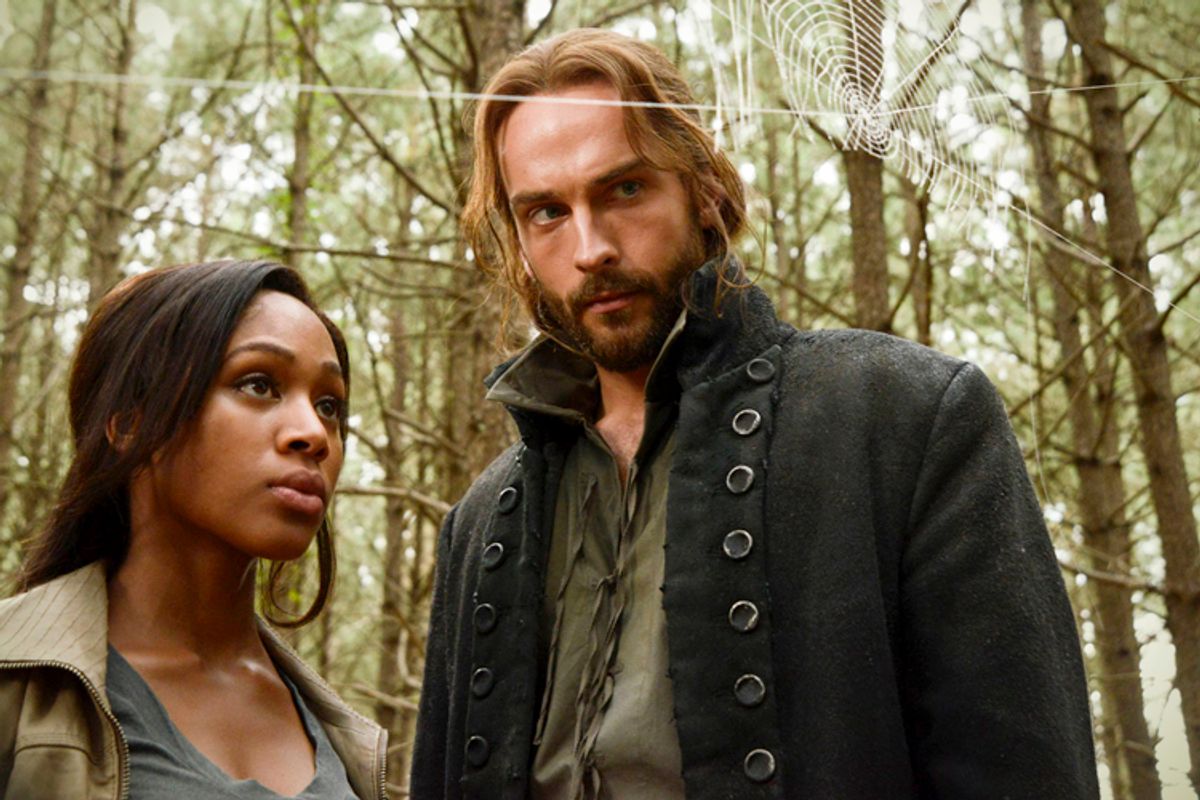During last night's episode of "Sleepy Hollow," displaced Revolutionary soldier Ichabod Crane and small town police officer Abbie Mills bonded over baseball. Crane listened, bemused, as the diminutive lieutenant expounded upon the beauty of the game. "It's about teamwork," she insists. "The players have to have faith in each other and watch each other's backs because without that, the team don't work."
Mills, who is black, went on to laud the egalitarian nature of the sport, explaining that baseball "does not discriminate." Sure, her idealism sounded a little hokey, but Nicole Beharie, who plays Mills, is admirably adept at animating even the most rote exposition. Beharie's scene partner, the lithe, handsome Tom Mison, sopped up her earnestness with those mischievous green eyes of his and the barest of smiles before thanking her for the outing and bowing politely before her as befit a man of his time.
This adorable moment was charged with the potential for romance with which the creators of "Sleepy Hollow" have been teasing viewers since the program's premiere. It was also over all too quickly. During the ensuing 40 minutes, Crane's long-dead wife appeared to Mills in ghost form to explain the "blood tie" between Crane and the Pale Horseman of the Apocalypse and a plot by Freemasons to kidnap Crane and force him to commit suicide emerged. At least, I think that's what the episode was about; I drifted off to sleep soon after the baseball thing.
After perusing former Salon critic and Slate writer Willa Paskin's Twitter feed, I was much relieved to find that I am not the only person on whom "Sleepy Hollow" occasionally -- ironically -- has this affect. "I know Sleepy Hollow is 'zany' and I like the two leads very much, but it knocks me out like an ambien," Paskin wrote. "Sleepy Hollow" is one of those shows like "Elementary" and its direct ancestor "The X-Files" that relies on a delicate balance between the chemistry of its two main characters and the often kooky, serpentine investigations that bind them together. In most such cases the former inevitably evolves into romance in the course of searching for hidden truths. Mills and Crane make for an odd couple -- she's short, he's tall, she's African-American, he's British and over 200 years old -- but their rapport is undeniable.
Though they are from the same century, "Elementary's" Holmes and Watson are also a mismatch. That show's creators have done a remarkable job of bringing the two together without forcing the issue of their romantic attraction. When it premiered last year, Watson was Holmes' sober companion, helping the brilliant but troubled investigator put his struggles with substance abuse behind him. Understandably, that got a little old. Nowadays, Watson has developed into something of a junior detective and, even though she's still very protective of Holmes' mental health and emotional stability, their relationship has become more of a dark mentorship program. At the the end of the day, "Elementary" is a procedural; its case-per-week format can get a bit tedious. But having Sherlock Holmes challenge Watson to hone her deductive reasoning whenever possible provides the show with forward momentum and ample opportunity for friction -- romantic and otherwise -- between the characters.
"Sleepy Hollow" is more of a modified procedural, wherein, each week, the duo investigate a different element of the same persistent problem: forestalling the arrival of the Four Horsemen of the Apocalypse. When "Sleepy Hollow" began, its core mythology was immediately a complicated amalgam of biblical prophecy and Revolutionary Era conspiracy lore. In just a few episodes, we have arrived at a dense web that includes Salem witches, demons from Revelations, Freemasons, ghosts, freed slaves, George Washington the occultist, and the Boston Tea Party. Personally, I find it increasingly difficult to keep the different threads in order in my mind, especially when -- the truth is -- I am most interested in the growing relationship between the two leads.
So, is it just me (and Willa Paskin)? Does anyone else think "Sleepy Hollow" is getting mired in its own mythology? And does it even matter, as long as Abbie Mills and Ichabod Crane continue to make eyes at each other between Headless Horseman attacks?



Shares